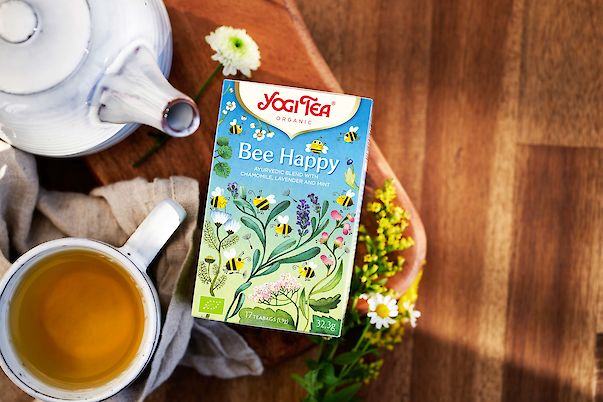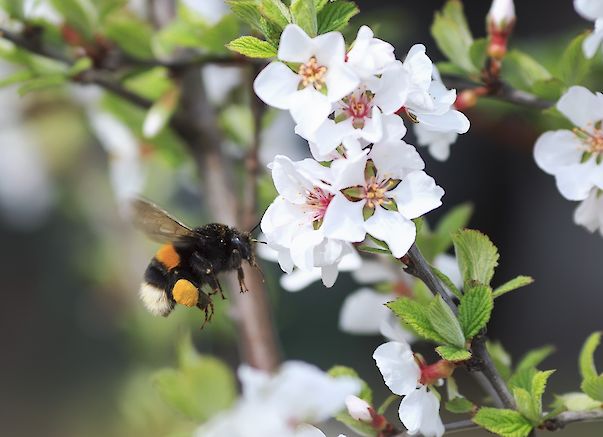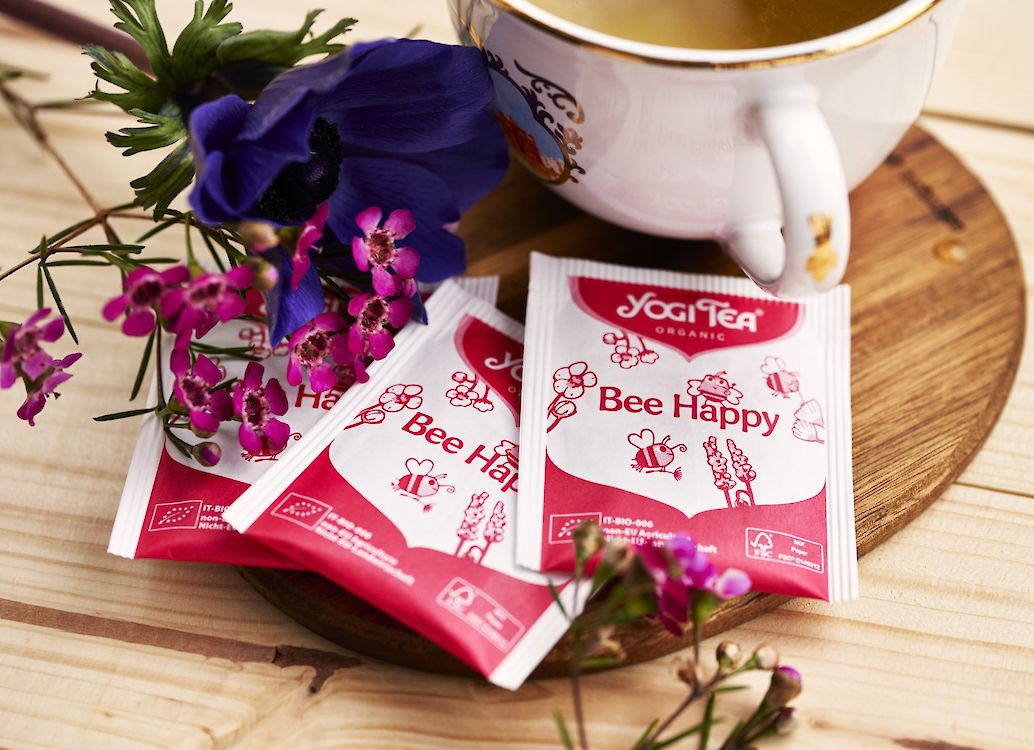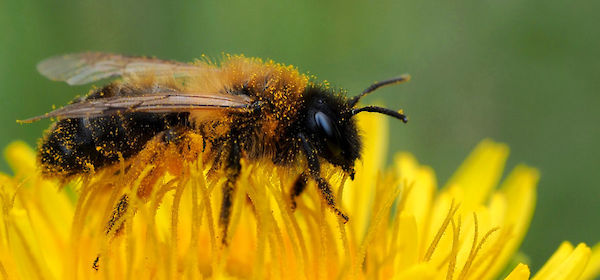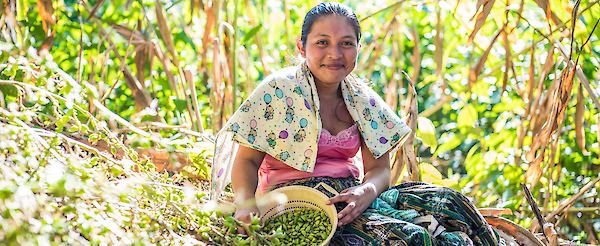In what way can we help wild bees? An interview with the German Wildlife Foundation
Many of you will have discovered it already: our YOGI TEA® Bee Happy. A floral and fresh herbal tea blend that makes everyone happy – especially our wild bees! That’s because all the wild flowers and herbs we use in this tea are important sources of food for endangered wild bees.
The idea behind a bee-friendly tea is close to our hearts at YOGI TEA®. We have always focused on being mindful of nature, of each other and of ourselves, in everything we do. And making a commitment to protecting biodiversity is an important part of this. And so in 2020, YOGI TEA began a partnership with the Deutsche Wildtier Stiftung (German Wildlife Foundation), which supports endangered wild animals, protects native species and preserves habitats.
What exactly is the sustainable protection of wild bees all about? What can we, as a society and as individuals, do to help maintain biodiversity? And what actually makes a tea bee-friendly? To answer all these questions and more, we invited Manuel Pützstück, Project Coordinator at the Deutsche Wildtier Stiftung, to join us for an interview.
1. Hello Mr Pützstück. We often hear about native insects such as wild bees being endangered. Why is that?
Everyone is talking about insects dying out, and rightly so! More than half of the wild bee species accounted for in Germany are now on the red list of endangered species. The main reason for insects being endangered is the impact of humans on their habitats. The intensification of farming, acceleration of urbanisation in towns and cities and the associated soil sealing are leading to the loss of more and more structures that are vital for many insects to survive. The situation is particularly dangerous for highly specialised insects like wild bees. Many wild bees have focussed on certain plants for food and nesting places. Around 75% of native species are ground-nesting bees, which burrow their nests in the ground or use existing hollows in the ground. Their requirements can be so specific that they might only settle in sandy or clay soils.
Other species nest in the cracks of rocks or walls or colonise hollows or construct their own nests made of mud. Tunnels made by woodworm in dead wood can also be used intensively by wild bees. Nesting opportunities for other wild bees can be found in cavities in hollow stems or even in empty snail shells. The bees line and seal their nests with their own secretions, tiny fragments of leaves, plant hairs, mortar and resins.
Many species of wild bees are also limited in their choice of plants as sources of food. Wild bees are genuine vegetarians and feed exclusively on nectar, which contains sugar, and pollen, which is rich in protein. As well as some species that collect pollen from many varieties of plant,there are also some genuine specialists, which depend on individual plant species and their flowering phases. The pollen is used to feed their young, whilst nectar is mainly used as a source of energy and ‘fuel” for the adult bees to be able to fly.
Only when a habitat offers the right nesting sites and requirements, as well as suitable sources of food, can it be inhabited on a long-term basis by wild bees. The loss of diversity in our landscapes and the decline of wild bees therefore go hand in hand.
2. Why is it important to protect wild bees?
The monetary value of the pollination carried out by insects is estimated to be around EUR 15 billion per year in Europe alone. Wild bees make a considerable contribution to this and we are completely reliant on them, as well as on honey bees and other insects such as hoverflies, to pollinate agricultural and wild plants. All native species of wild bee are frequent visitors to flowering plants. This is where they collect nectar and pollen. Wild bees are particularly efficient pollinators, making a significant contribution towards ensuring our supply of food, particularly fruit and vegetables. This means that wild bees are a vital component of our native ecosystem.
In Germany alone, there are around 580 native wild bee species, but almost half of these are already endangered and that is truly alarming. Protecting wild bees is therefore an important public issue.
3. In what way can we help wild bees?
Bees are discerning creatures, requiring a high level of structural diversity before they can reproduce, including a rich supply of flowering plants and the nesting opportunities I have already mentioned. In our towns and cities, gardens, public parks, cemeteries and brownfield sites offer a great opportunity for wild bees, provided that they are well-organised and include native species of plants. That’s why there are many different species of wild bee in urban areas, including some endangered species.
The projects led by the Deutsche Wildtier Stiftung aim above all to create new habitats. Together with our partners – such as YOGI TEA – we are trying to increase the flowers available to wild bees and to extend the growing season overall. The provision of natural nesting structures that fulfil the special requirements of wild bees is another important step towards supporting the continuation of the species.
Educational work is another key area when it comes to protecting wild bees.
4. What makes our Bee Happy tea bee-friendly?
What’s special about YOGI TEA® Bee Happy is that great attention has been paid to ensuring that the tea blend predominantly uses ingredients that are a favourite source of food for many wild bees. Since all the plants used are only harvested once they have finished flowering, the production of the tea ensures a variety of flowering plants as a source of food for the wild bees. By providing artificial nest boxes at selected growing sites, we are also creating bee-friendly habitats and nesting sites.
Composite plants like chamomile and yarrow have a very important role to play for wild bees, especially in summer. Cavity-nesting bees, polyester and plasterer bees are frequent visitors. Labiates such as thyme, sage, rosemary, peppermint, oregano and lavender are also a favourite of many bees, including many of the nutritional specialists. This is where you can find furry bees, wool carder bees, the rare rophites and bumblebees.
5. There are always plenty of bees to be seen in summer: how can I tell whether they are wild bees or honey bees? And why is it important to make this distinction?
It’s important to differentiate because honey bees and wild bees are in competition with each other for pollen and nectar, due to the constant depletion of flowering landscapes. When there is an extreme lack of flowering plants and a lot of honey beehives, this can lead to a level of competition in which the wild bees cannot collect enough pollen,thus endangering their chances of successful reproduction. As they provide food for human consumption, honey bees are not endangered and, as generalists, are a lot less choosy than wild bees when it comes to finding food.
Most wild bee species can be recognised by their furry or hairy appearance. The female bees also have special hairs on their rear legs or under their bellies, which they use to transport pollen. When you look more closely, you can often see the bees’ filled pollen pellets. The 40 or so types of bumblebee in Germany are also wild bees. As well as the furry types of wild bee, there are also some species that have no hair at all. Many of them, in particular the cuckoo bee, are strikingly yellow and black or red and black. They are easy to mistake for various types of wasp. Masked bees, which are black and inconspicuous and often have a body length of less than a centimetre, often look more like wasps than wild bees. The smallest bees in Germany, sweat bees, measure just four millimetres along the length of their bodies. They can now only be found in just a few areas with sandy soil in the Upper Rhine region.
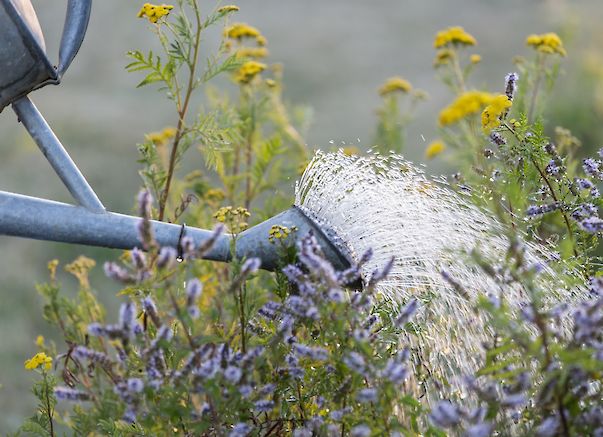
6. What can I do as an individual to help bees, in my garden or on my balcony for example?
There are still many common species of wild bee to be found in most cities – and there are some promising ways to make your own garden or balcony a suitable source of food and nesting site.
When choosing plants, it is important to introduce the greatest possible variety of native wild flowers. This will help as many species of wild bee as possible to find suitable food. Where possible, there should also be flowering plants throughout the entire growing season, from March through to October at least.
Depending on the season, the following types of plant are good sources of nutrition for bees and can be grown in your own garden:
Spring: Flowering shrubs and trees, such as apple, hawthorn, willow, blackthorn, plum. Early blossoming plants like shepherd’s purse, dead nettle, crocus or aubretia.
Early summer: A variety of meadow flowers, herbs such as dill or fennel, vetch and chickling pea, stonecrop, viper’s bugloss and bulbous plants.
High summer: Perennials such as older herbs, aster and tansy.
You should, however, be careful with many cultivated varieties of garden plant, such as asters, dahlia or marigolds. Their flowers are often “filled” and their nectar inaccessible to bees. You can tell whether a plant has “filled” flowers – and is therefore not useful for wild bees – by the Latin suffix fl. pl. (flore pleno meaning “with full flowers”) after its name.
Of course you should make sure that you that don’t use any kind of pesticide in your garden.
Another way you can support bees is by providing artificial wild bee nest boxes. Then you will be able to sit back and observe a fascinating variety of wildlife in your own garden or balcony.
Thank you Mr Pützstück for the interesting interview.
